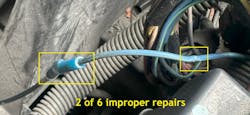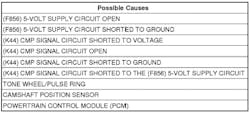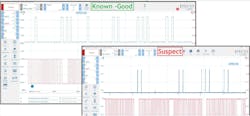Untangling a Jeep's wiring after 3 engine replacements
A client of mine was faced with a 2008 Jeep Wrangler with a 3.8L engine. For unknown reasons, the engine was previously replaced with three different units, and at least one replacement PCM. Upon receiving the request for help, they were pursuing two existing DTCs:
- P0340 “Camshaft position sensor circuit”
- P0344 “Camshaft position sensor intermittent”
Initial Analysis
After preliminary research of the DTCs, the service information reflected that the existing fault could be caused by either a circuit issue or a mechanical fault (Figure 1). Considering I’m more than 1,500 miles away, I have some concerns with the fact that the engine wiring harness was manipulated so many times. The potential for connector/terminal/wire/component damage grows more likely with each engine replacement. With that a few things came to mind and I first had the tech send me pictures of the CMP sensor pigtail/wire harness (Figure 2).
I was not surprised to see the damaged and poorly repaired wiring harness. But here's the question,“Is this the root cause of the fault or is this just a botched attempt to fix it?” The good news is that we can clear the DTCs and they will return within several seconds of starting the engine. In other words, we have no problem reproducing the fault.
Brass Tactics
It’s obvious the tech was not comfortable with proper wiring repair, but I have a job to do as a tech support data analyst. So, instead of fumbling around with subsequent attempts, I chose to instruct him to leverage the multi-trace lab scope and capture data downstream from the botched wiring repairs. The best place to do this was at the back side of the PCM connector. I advised him to use pierce probes rather than back probes in a situation like this. Back probes could in fact enhance the connection at an otherwise poor fitment issue in a connector. He captured the CKP and CMP signals for me to review. I analyzed the data files and zoomed in to an area that I could compare to a sample from a known-good vehicle (Figure 3). Clearly, there is a fault, but is it internal to the engine or circuit related?
The Data Doesn’t Lie
With all the information in front of us, and the desired information not yet obtained, we are faced with deciding how to proceed. Here are some bullet points of what we know to be factual, and I will ask all of you, diligent readers, for your input on what they mean to you, collectively:
- CMP-related DTCs exist and are current
- Fault could be circuit or mechanically related
- Obvious damage to harness and connection exists and must be rectified
- An underlying fault may still exist once the circuit has been repaired
Given this information, what would you do next?
- Fix wiring first and re-examine
- Replace the CMP sensor and re-examine
- Condemn the CMP reluctor for improper configuration
- Inspect CMP reluctor with a borescope
About the Author
Brandon Steckler
Technical Editor | Motor Age
Brandon began his career in Northampton County Community College in Bethlehem, Pennsylvania, where he was a student of GM’s Automotive Service Educational program. In 2001, he graduated top of his class and earned the GM Leadership award for his efforts. He later began working as a technician at a Saturn dealership in Reading, Pennsylvania, where he quickly attained Master Technician status. He later transitioned to working with Hondas, where he aggressively worked to attain another Master Technician status.
Always having a passion for a full understanding of system/component functionality, he rapidly earned a reputation for deciphering strange failures at an efficient pace and became known as an information specialist among the staff and peers at the dealership. In search of new challenges, he transitioned away from the dealership and to the independent world, where he specialized in diagnostics and driveability.
Today, he is an instructor with both Carquest Technical Institute and Worldpac Training Institute. Along with beta testing for Automotive Test Solutions, he develops curriculum/submits case studies for educational purposes. Through Steckler Automotive Technical Services, LLC., Brandon also provides telephone and live technical support, as well as private training, for technicians all across the world.
Brandon holds ASE certifications A1-A9 as well as C1 (Service Consultant). He is certified as an Advanced Level Specialist in L1 (Advanced Engine Performance), L2 (Advanced Diesel Engine Performance), L3 (Hybrid/EV Specialist), L4 (ADAS) and xEV-Level 2 (Technician electrical safety).
He contributes weekly to Facebook automotive chat groups, has authored several books and classes, and truly enjoys traveling across the globe to help other technicians attain a level of understanding that will serve them well throughout their careers.



